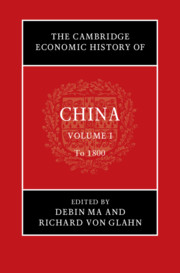Book contents
- The Cambridge Economic History of China
- The Cambridge Economic History of China
- The Cambridge Economic History of China
- Copyright page
- Contents
- Figures
- Maps
- Tables
- Contributors to Volume I
- Acknowledgments
- Note on Citations
- Introduction to Volume I
- Part I Before 1000
- 1 The Economy of Late Pre-imperial China
- 2 Agriculture and Its Environmental Impact
- 3 State and Economy
- 4 Money, Markets, and Merchants
- 5 Economic Philosophy and Political Economy
- 6 Silk Road Trade and Foreign Economic Influences
- Interlude
- Part II 1000 to 1800
- Bibliography of Primary Works Cited
- Index
- References
3 - State and Economy
Production, Extraction, and Distribution
from Part I - Before 1000
Published online by Cambridge University Press: 07 February 2022
- The Cambridge Economic History of China
- The Cambridge Economic History of China
- The Cambridge Economic History of China
- Copyright page
- Contents
- Figures
- Maps
- Tables
- Contributors to Volume I
- Acknowledgments
- Note on Citations
- Introduction to Volume I
- Part I Before 1000
- 1 The Economy of Late Pre-imperial China
- 2 Agriculture and Its Environmental Impact
- 3 State and Economy
- 4 Money, Markets, and Merchants
- 5 Economic Philosophy and Political Economy
- 6 Silk Road Trade and Foreign Economic Influences
- Interlude
- Part II 1000 to 1800
- Bibliography of Primary Works Cited
- Index
- References
Summary
The integrity and durability of the Chinese empire over two millennia rested on the strength of its fiscal capacity. From antiquity, sovereignty was linked to the ruler’s duty to provide for the economic as well as moral welfare of his subjects. Rulers of the Bronze Age manifested and reproduced their authority through distribution of wealth among their kinsmen and noble allies. The autocratic monarchs who rose to dominance after 500 bce amassed wealth to buttress their military prowess, but they also strove to protect the independence and livelihood of the smallholder family farmers who undergirded their economic prosperity. The institutional apparatus of the fiscal state – centralized planning of taxation and expenditure to satisfy the state’s commitments to good governance – became a defining feature of the first empires, beginning with the Qin dynasty (221–206 bce). Yet at the same time the rise of a market economy also shaped the relationship between the state and its subjects. Even the command economy instituted by the Qin Empire made accommodations to markets, merchants, and money.
Keywords
- Type
- Chapter
- Information
- The Cambridge Economic History of China , pp. 92 - 130Publisher: Cambridge University PressPrint publication year: 2022



